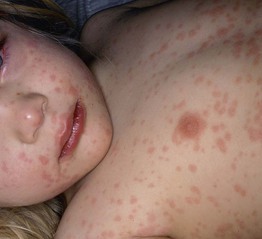68
Other Viral Diseases
Viral infections frequently have cutaneous manifestations, especially in children. This chapter covers classic childhood exanthems, poxvirus infections, and several other viral infections with characteristic skin findings. Nonspecific viral exanthems, typically presenting with blanchable erythematous macules and papules in a widespread distribution, are also common in children infected with enteroviruses (see below) and a variety of respiratory viruses, generally resolving spontaneously within a week. Fig. 68.1 outlines clinical features to consider when evaluating a patient with a morbilliform (‘maculopapular’) exanthem, and Chapter 3 addresses considerations in patients with fever and a rash. HIV, human papillomavirus, and herpesvirus (including infectious mononucleosis and roseola infantum) infections are discussed in Chapters 65–67.
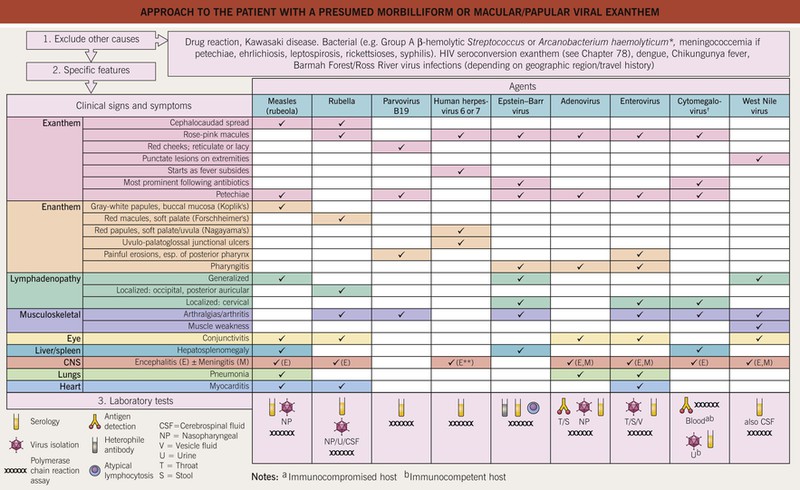
Fig. 68.1 Approach to the patient with a presumed morbilliform or macular/papular viral exanthem. *Gram-positive rod; may result in severe pharyngitis and scarlatiniform exanthem in adolescents and young adults. †Intracellular inclusions in endothelial cells are another finding. **Usually febrile seizures.
Enterovirus Infections
• Hand, foot, and, mouth disease (HFMD; in the United States, coxsackievirus A16 > others) features oval vesicles on the hands and feet (palms/soles > dorsally) and buttocks plus an erosive stomatitis (e.g. tongue, buccal mucosa, palate, tonsils), often associated with fever and malaise (Fig. 68.2A–D); onychomadesis occasionally occurs 1–2 months later.
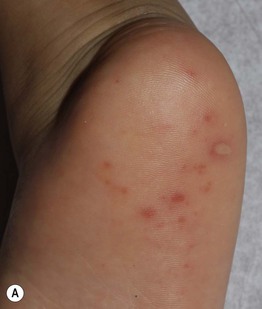
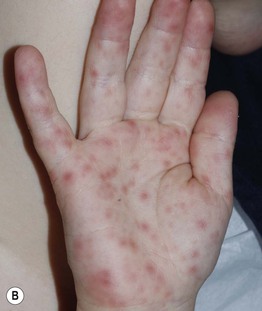
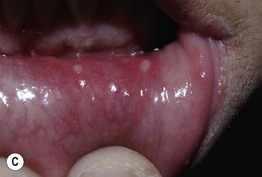
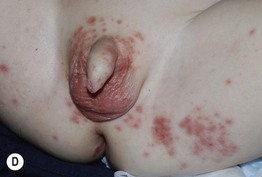
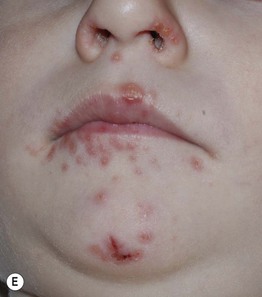
Fig. 68.2 Hand, foot, and mouth disease (HFMD). A Oval vesicle and erythematous macules on the plantar surface. B Multiple erythematous macules on the palm, some with a dusky appearance reminiscent of erythema multiforme. C Small oval erosions on the buccal mucosa resembling aphthae. D Discrete erythematous papules and crusted erosions in an area of previous diaper dermatitis. The differential diagnosis in this patient with coxsackievirus A6 infection might include eczema herpeticum. E Extensive vesicles and crusts in the perioral area in a patient with HFMD due to coxsackievirus A6. Herpes simplex virus infection or impetigo may be considered in the differential diagnosis for lesions in this location. Note koebnerization to the site of a healing laceration on the chin. A, B, D, E, Courtesy, Julie V. Schaffer, MD; C, Courtesy, Kalman Watsky, MD.
• Recently, coxsackievirus A6 infection has been associated with a more widespread vesiculobullous exanthem favoring the perioral area, extremities > trunk, and areas of previous dermatitis (‘eczema coxsackium’) or injury as well as the classic sites of HFMD (Fig. 68.2B, D, E; see Fig. 3.5B, C).
• Herpangina presents with fever and oropharyngeal erosions, but usually no exanthem.
• The diverse spectrum of enteroviral exanthems also includes morbilliform, scarlatiniform, Gianotti–Crosti syndrome-like, petechial, and pustular eruptions (see Fig. 3.5A); eruptive pseudoangiomatosis is an uncommon manifestation.
Measles (Rubeola)
• Highly contagious and spread by respiratory droplets, with an incubation period of 10–14 days.
• An exanthem develops 3–5 days after the onset of symptoms, with erythematous macules and papules spreading cephalocaudally from the forehead, hairline, and behind the ears to the trunk and extremities (Fig. 68.3); after 5 days, the eruption fades in the order it appeared.
• Rx: vitamin A administration for children with acute disease; prevention via vaccination.
Rubella (German Measles)
• Spread via respiratory droplets, with an incubation period of 16–18 days.
• Congenital rubella syndrome, most common with maternal infection in the first 16 weeks of pregnancy; can result in cataracts, deafness, congenital heart defects, and microcephaly; a ‘blueberry muffin baby’ presentation occasionally occurs (see Fig. 67.15).
